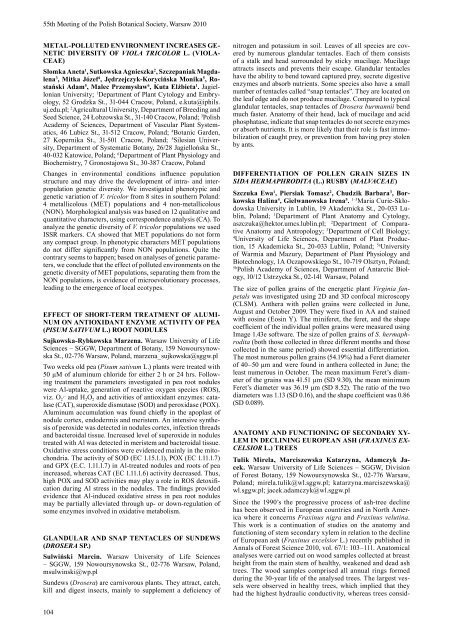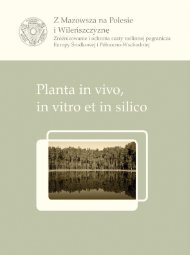acta societatis botanicorum poloniae - LV Zjazd Polskiego ...
acta societatis botanicorum poloniae - LV Zjazd Polskiego ...
acta societatis botanicorum poloniae - LV Zjazd Polskiego ...
Create successful ePaper yourself
Turn your PDF publications into a flip-book with our unique Google optimized e-Paper software.
55th Meeting of the Polish Botanical Society, Warsaw 2010<br />
METAL-POLLUTEd ENVIrONMENT INCrEASES GE-<br />
NETIC dIVErSITY OF violA tricolor L. (VIOLA-<br />
CEAE)<br />
Słomka Aneta1 , Sutkowska Agnieszka 2 , Szczepaniak Magdalena3<br />
, Mitka Józef4 , Jędrzejczyk-Korycińska Monika5 , rostański<br />
Adam5 , Malec Przemysław6 , Kuta Elżbieta1 . Jagiellonian<br />
University; 1Department of Plant Cytology and Embryology,<br />
52 Grodzka St., 31-044 Cracow, Poland, e.kuta@iphils.<br />
uj.edu.pl; 2Agricultural University, Department of Breeding and<br />
Seed Science, 24 Łobzowska St., 31-140 Cracow, Poland; 3Polish Academy of Sciences, Department of Vascular Plant Systematics,<br />
46 Lubicz St., 31-512 Cracow, Poland; 4Botanic Garden,<br />
27 Kopernika St., 31-501 Cracow, Poland; 5Silesian University,<br />
Department of Systematic Botany, 26/28 Jagiellońska St.,<br />
40-032 Katowice, Poland; 6Department of Plant Physiology and<br />
Biochemistry, 7 Gronostajowa St., 30-387 Cracow, Poland<br />
Changes in environmental conditions influence population<br />
structure and may drive the development of intra- and interpopulation<br />
genetic diversity. We investigated phenotypic and<br />
genetic variation of V. tricolor from 8 sites in southern Poland:<br />
4 metallicolous (MET) populations and 4 non-metallicolous<br />
(NON). Morphological analysis was based on 12 qualitative and<br />
quantitative characters, using correspondence analysis (CA). To<br />
analyze the genetic diversity of V. tricolor populations we used<br />
ISSR markers. CA showed that MET populations do not form<br />
any compact group. In phenotypic characters MET populations<br />
do not differ significantly from NON populations. Quite the<br />
contrary seems to happen; based on analyses of genetic parameters,<br />
we conclude that the effect of polluted environments on the<br />
genetic diversity of MET populations, separating them from the<br />
NON populations, is evidence of microevolutionary processes,<br />
leading to the emergence of local ecotypes.<br />
EFFECT OF SHOrT-TErM TrEATMENT OF ALUMI-<br />
NUM ON ANTIOxIdANT ENZYME ACTIVITY OF PEA<br />
(Pisum sAtivum L.) rOOT NOdULES<br />
Sujkowska-rybkowska Marzena. Warsaw University of Life<br />
Sciences – SGGW, Department of Botany, 159 Nowoursynowska<br />
St., 02-776 Warsaw, Poland, marzena_sujkowska@sggw.pl<br />
Two weeks old pea (Pisum sativum L.) plants were treated with<br />
50 μM of aluminum chloride for either 2 h or 24 hrs. Following<br />
treatment the parameters investigated in pea root nodules<br />
were Al-uptake, generation of reactive oxygen species (ROS),<br />
viz. O 2∙ - and H 2O 2 and activities of antioxidant enzymes: catalase<br />
(CAT), superoxide dismutase (SOD) and peroxidase (POX).<br />
Aluminum accumulation was found chiefly in the apoplast of<br />
nodule cortex, endodermis and meristem. An intensive synthesis<br />
of peroxide was detected in nodules cortex, infection threads<br />
and bacteroidal tissue. Increased level of superoxide in nodules<br />
treated with Al was detected in meristem and bacteroidal tissue.<br />
Oxidative stress conditions were evidenced mainly in the mitochondria.<br />
The activity of SOD (EC 1.15.1.1), POX (EC 1.11.1.7)<br />
and GPX (E.C. 1.11.1.7) in Al-treated nodules and roots of pea<br />
increased, whereas CAT (EC 1.11.1.6) activity decreased. Thus,<br />
high POX and SOD activities may play a role in ROS detoxification<br />
during Al stress in the nodules. The findings provided<br />
evidence that Al-induced oxidative stress in pea root nodules<br />
may be partially alleviated through up- or down-regulation of<br />
some enzymes involved in oxidative metabolism.<br />
GLANdULAr ANd SNAP TENTACLES OF SUNdEWS<br />
(droserA SP.)<br />
Sulwiński Marcin. Warsaw University of Life Sciences<br />
– SGGW, 159 Nowoursynowska St., 02-776 Warsaw, Poland,<br />
msulwinski@wp.pl<br />
Sundews (Drosera) are carnivorous plants. They attract, catch,<br />
kill and digest insects, mainly to supplement a deficiency of<br />
104<br />
nitrogen and potassium in soil. Leaves of all species are covered<br />
by numerous glandular tentacles. Each of them consists<br />
of a stalk and head surrounded by sticky mucilage. Mucilage<br />
attracts insects and prevents their escape. Glandular tentacles<br />
have the ability to bend toward captured prey, secrete digestive<br />
enzymes and absorb nutrients. Some species also have a small<br />
number of tentacles called “snap tentacles”. They are located on<br />
the leaf edge and do not produce mucilage. Compared to typical<br />
glandular tentacles, snap tentacles of Drosera burmannii bend<br />
much faster. Anatomy of their head, lack of mucilage and acid<br />
phosphatase, indicate that snap tentacles do not secrete enzymes<br />
or absorb nutrients. It is more likely that their role is fast immobilization<br />
of caught prey, or prevention from having prey stolen<br />
by ants.<br />
dIFFErENTIATION OF POLLEN GrAIN SIZES IN<br />
sidA hermAPhroditA (L.) rUSBY (mAlvAceAe)<br />
Szczuka Ewa1 , Piersiak Tomasz2 , Chudzik Barbara3 , Borkowska<br />
Halina4 , Giełwanowska Irena5 . 1–3Maria Curie -Skłodowska<br />
University in Lublin, 19 Akademicka St., 20-033 Lublin,<br />
Poland; 1Department of Plant Anatomy and Cytology,<br />
aszczuka@hektor.umcs.lublin.pl; 2Department of Comparative<br />
Anatomy and Antropology; 3Department of Cell Biology;<br />
4University of Life Sciences, Department of Plant Production,<br />
15 Akademicka St., 20-033 Lublin, Poland; 5aUniversity of Warmia and Mazury, Department of Plant Physiology and<br />
Biotechnology, 1A Oczapowskiego St., 10-719 Olsztyn, Poland;<br />
5bPolish Academy of Sciences, Department of Antarctic Biology,<br />
10/12 Ustrzycka St., 02-141 Warsaw, Poland<br />
The size of pollen grains of the energetic plant Virginia fanpetals<br />
was investigated using 2D and 3D confocal microscopy<br />
(CLSM). Anthera with pollen grains were collected in June,<br />
August and October 2009. They were fixed in AA and stained<br />
with eosine (Eosin Y). The miniferet, the feret, and the shape<br />
coefficient of the individual pollen grains were measured using<br />
Image 1.43e software. The size of pollen grains of S. hermaphrodita<br />
(both those collected in three different months and those<br />
collected in the same period) showed essential differentiation.<br />
The most numerous pollen grains (54.19%) had a Feret diameter<br />
of 40– 50 µm and were found in anthera collected in June; the<br />
least numerous in October. The mean maximum Feret’s diameter<br />
of the grains was 41.51 µm (SD 9.30), the mean minimum<br />
Feret’s diameter was 36.19 µm (SD 8.52). The ratio of the two<br />
diameters was 1.13 (SD 0.16), and the shape coefficient was 0.86<br />
(SD 0.089).<br />
ANATOMY ANd FUNCTIONING OF SECONdArY xY-<br />
LEM IN dECLINING EUrOPEAN ASH (frAxinus excelsior<br />
L.) TrEES<br />
Tulik Mirela, Marciszewska Katarzyna, Adamczyk Jacek.<br />
Warsaw University of Life Sciences – SGGW, Division<br />
of Forest Botany, 159 Nowoursynowska St., 02-776 Warsaw,<br />
Poland; mirela.tulik@wl.sggw.pl; katarzyna.marciszewska@<br />
wl.sggw.pl; jacek.adamczyk@wl.sggw.pl<br />
Since the 1990’s the progressive process of ash-tree decline<br />
has been observed in European countries and in North America<br />
where it concerns Fraxinus nigra and Fraxinus velutina.<br />
This work is a continuation of studies on the anatomy and<br />
functioning of stem secondary xylem in relation to the decline<br />
of European ash (Fraxinus excelsior L.) recently published in<br />
Annals of Forest Science 2010, vol. 67/1: 103– 111. Anatomical<br />
analyses were carried out on wood samples collected at breast<br />
height from the main stem of healthy, weakened and dead ash<br />
trees. The wood samples comprised all annual rings formed<br />
during the 30-year life of the analysed trees. The largest vessels<br />
were observed in healthy trees, which implied that they<br />
had the highest hydraulic conductivity, whereas trees consid-



